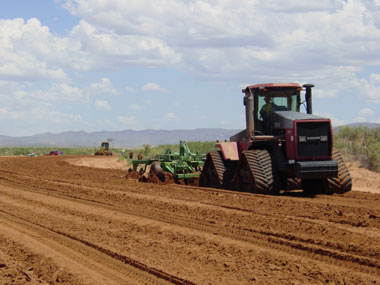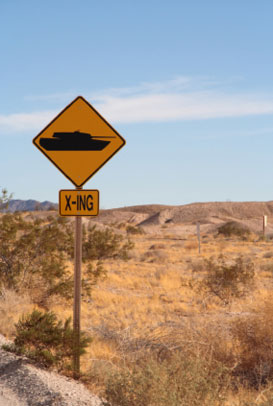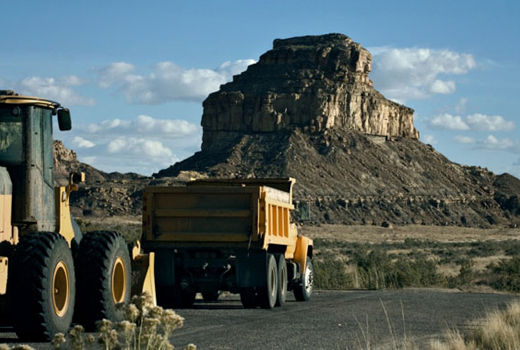Next Generation Green Road Stabilization
Next generation road and highway engineering and construction product technologies are breaking with convention and advancing sustainability. One emergent alternative is a greener way to stabilize aggregate and soil on transportation infrastructure projects. Roads and highways require stabilized or structural layers built well below the driving surface to support the weight and stress heavy traffic inflicts over time. But, traditional construction practices are highly inefficient and can harm surrounding communities and ecosystems. Green stabilization technology developers are reinventing the wheel – or at least the roads – with a relatively new process that lowers costs, improves road performance and decreases harmful environmental impacts associated with construction.
Thanks to stabilized native soil and stabilized aggregate layers, the U.S. Army’s reconstructed heavy haul roads at Texas’ Fort Bliss are now successfully stretching the structural limits of this innovative construction technology. Subject to enormous weight and stress from heavy armor and equipment transporters, the installation’s green road stabilization technology is proving to be stronger and more durable than more conventional cement and asphalt stabilization and support applications.
One innovative firm helping to develop these cleaner, advanced stabilization techniques is Soil Stabilization Products Company, Inc. (SSPCo). This pioneering team consists of former aggregate and pavement materials suppliers and road construction engineering contractors. Harnessing their collective industry background and knowledge, these individuals holistically analyzed the costs and benefits of conventional road construction practices. Green stabilization was a solution developed to maximize construction efficiency and minimize associated negative externalities that can lead to environmental degradation and health problems. Green stabilization makes use of construction sites’ readily available local resources, leaves the smallest possible environmental footprint and maximizes return on budget-constrained investments.
Conventional road and highway construction often use layers of crushed base rock or other aggregate materials to provide driving surface structure and stabilization. However, these support stratums are often treated with chemicals to bind together the soil, crushed rock or other aggregate base materials. Two traditional but different binding methods are asphalt– and cement-based treatments. With asphalt emulsions, crushed aggregate materials are treated with sticky crude-oil-based asphalt and are joined together in a strong but viscoelastic support system. Other times, the soils underlying the road surface are stabilized with large amounts of fine-sized, calcium-based powder products such as cement, fly ash, cement kiln dust and lime. Calcium-based soil stabilization methods create a hard, often brittle layer of support beneath the road surface.
Saving Green by Being Green
A standard methodology until recently, traditional calcium- and asphalt-based road and highway construction installations play host to environmental problems and increased costs. Emergent and innovative greener stabilization technologies address many of these concerns, which includes toxicity and human health problems – two of the most severe ecological effects. Cement, fly ash and lime treatments are common examples. Highly corrosive and dangerous, these chemicals require construction personnel to wear special protective clothing. Sometimes these stabilization chemicals may be applied as a powder. If the particles become airborne, they can become public health hazards, making the air lethal to breathe and tainting groundwater. Airborne contaminants can even corrode structures, equipment, vehicles and aircraft in the construction project’s vicinity. When associated ecosystem impacts are included, these traditional soil stabilization methods become even less desirable.

Photo Credit: SSPCo
Green stabilization techniques are a marked improvement compared with sulfuric acid and highly alkaline calcium-based treatments. They have a neutral-pH, are non-toxic, non-hazardous, non-flammable and non-corrosive. Many private industries and public agencies with strict environmental review policies have already chosen this new system over conventional road construction practices due to its low environmental impact. For example, a growing list of Federal agencies with major land management responsibilities has commissioned SSPCo’s EMC SQUARED green soil stabilization in road construction projects. These include the U.S. Air Force (USAF), U.S. Army, U.S. Army Corps of Engineers (USACE), Bureau of Indian Affairs (BIA), Bureau of Land Management (BLM), U.S. Forest Service (USFS) and National Park Service (NPS). Advanced, green soil stabilization technology was also field tested by the U.S. Environmental Protection Agency (EPA) as part of their National Estuary Program (NEP), which documented the product suitability for use “in sensitive environmental areas, such as through wetlands.”
Additional environmental impacts associated with traditional road construction projects come from extremely fossil fuel– and greenhouse gas– dependent mining and transportation activities needed to supply aggregate base materials or calcium dusts to construction sites. Crushed rock aggregate materials used in asphalt treatments are a limited resource that is quickly becoming exhausted. In addition, increasingly long hauls are necessary to transport aggregates because they are mined a significant distance from where they are utilized. A similar problem exists with calcium dust soil stabilization techniques like cement and lime. Both calcium– and asphalt-based road construction methods can require hundreds or even thousands of truck trips per single project. Green soil stabilization technologies solve this problem by capitalizing on locally occurring natural resources, such as native soils, instead of distantly mined materials. Furthermore, a conventional soil stabilization project using 100 truckloads of cement or lime powder would require only two truckloads of green soil stabilization product since the product is highly concentrated.
Environmental impacts aside, calcium-based soil stabilization methods are expensive and these treatments can produce destructive side-effects worse than the problems they were intended to solve. Both cement and lime treatments can be highly susceptible to moisture and the freeze-thaw cycle. Water and ice penetration can generate layer cracking and sulfate induced heave under the road surface. Within just once season, breakdown of these support layers can result in reflective cracking in the pavement and rough riding road surfaces that will need to be repaired or reconstructed. Aggregate and soil materials stabilized with these new green technologies are much more elastic than those treated with calcium-based products. This unique elastic characteristic makes the stabilized layers more moisture resistant and less susceptible to layer cracking and heave.
Asphalt pavement materials are also not without their unique problems. A sticky by-product of crude-oil distillation, asphalt is both a limited natural resource and far from being the cleanest option. Moreover, green stabilization treatments performed better than asphalt pavement materials at high temperatures in recent laboratory strength tests conducted by Peter Sebaaly, Ph.D., P.E., director of the Western Regional Superpave Center and professor of Civil and Environmental Engineering at the University of Nevada Reno. Sebaaly found that roads constructed with green stabilization technologies are most similar in Dynamic Modulus testing to those paved with Hot Mix Asphalt (HMA). However, because HMA pavement materials are viscoelastic in nature, they lose strength as pavement temperatures increase. During testing, the aggregate stabilized with the advanced green technology were equal in strength to HMA at most temperatures but performed significantly better than HMA at high temperatures because they did not lose strength.
Setting a new baseline comparison with emerging green soil stabilization technologies, one also observes that the high monetary cost of conventional road construction reflects a significant lack of efficiency. To illustrate, green soil stabilization technology used on a one mile long expressway project saved one city 25 per cent of the overall project cost because 640 aggregate material truckloads were eliminated. In addition to the cost savings associated with eliminating mining and transportation, green soil stabilization installation is easier and faster. No specialized equipment or sub-contractors are necessary. Also, the treatment products are highly concentrated and can often be stored on site. Add up the additional costs saved by eliminating each of the negative environmental externalities associated with asphalt– and calcium-based construction, and green soil stabilization saves not just on the short-term construction budget but also on long-term maintenance, repair, environment and health costs.
Pushing the Limits: Green Stabilization at Fort Bliss
Recently the USACE awarded contracts to replace eight of the old rough running haul road routes at Fort Bliss, the Army’s second largest installation and the second largest Maneuver Area for heavy armor training activities. More than 1,700 square miles (1.1 million acres) stretching across Texas and New Mexico make Fort Bliss larger than the state of Rhode Island. Hundreds of miles of roads are necessary to bisect this massive, ecologically and geologically diverse terrain. Many of these are unpaved heavy haul roads, also known as tank trails or military supply routes (MSR’s). Supporting convoys of Abrams Tanks, Bradley Infantry Fighting Vehicles, Paladin self-propelled Howitzers, armored vehicles, recovery vehicles, ambulances and heavy equipment transporter units, these heavy haul roads bear loads exceeding 243,000 pounds – loads heavier than those allowed on the Interstate Highway System.

© iStockphoto.com/1000kbps
In addition to the extreme stress and weight imposed by heavy military equipment, these routes must be able to withstand Fort Bliss’ extreme climate fluctuations. The area has an annual average of 20 days above 100° F and 60 nights below freezing. It has also experienced as much as two feet of snowfall in a single storm. In addition, the area is usually dry with an average 9.4 inches of rainfall per year, but extremely heavy summer monsoonal thunderstorms can create severe flash flooding with as much as 15 inches of rainfall in a single week. Because Fort Bliss heavy haul roads are unpaved, they have to be built strong enough to withstand these extreme weather conditions without protective surfaces.
USACE selected SSPCo’s green soil stabilization technique, EMC SQUARED, because of its superior strength, moisture resistance, cost savings and low environmental impact. Using this advanced green soil stabilization technology eliminated more than one million tons of crushed aggregate that would have needed to be mined and transported to the Fort Bliss construction sites. Alternatively, conventional road construction practices would have required more than 40,000 truckloads of aggregate materials at 25 tons per load. Estimating material and transportation cost savings at $20 per ton, green soil stabilization saved the USACE $20 million. Because of these savings, the $60 million budget was spread further and enabled reconstruction of more than 100 miles of Fort Bliss’ heavy haul roads.
Green stabilization technologies are extending sustainable building practices into the road and highway construction industry. While these next generation technologies might be the “new kids on the block” in road construction, project managers are increasingly breaking out of the old mold and preferring solutions that are both environmentally and economically beneficial. Success on the Fort Bliss heavy haul road construction project is a milestone. It demonstrates how advanced, green soil stabilization technologies trump traditional asphalt– and calcium-based road construction by pushing the limits with superior strength, low environmental impacts and significant cost savings





























